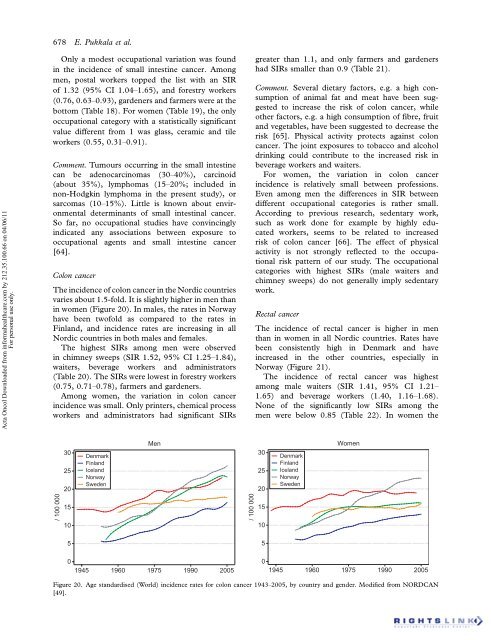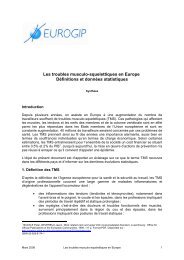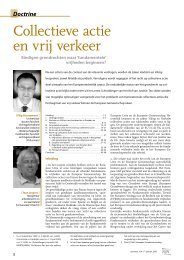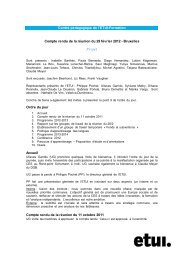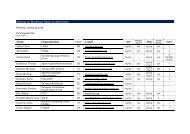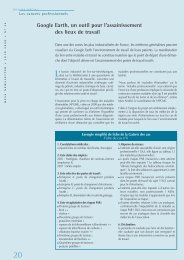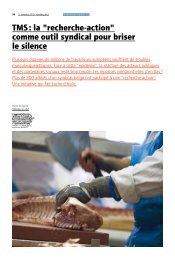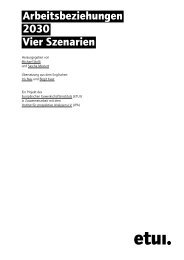Occupation and cancer - European Trade Union Institute (ETUI)
Occupation and cancer - European Trade Union Institute (ETUI)
Occupation and cancer - European Trade Union Institute (ETUI)
Create successful ePaper yourself
Turn your PDF publications into a flip-book with our unique Google optimized e-Paper software.
Acta Oncol Downloaded from informahealthcare.com by 212.35.100.66 on 04/06/11<br />
For personal use only.<br />
678 E. Pukkala et al.<br />
Only a modest occupational variation was found<br />
in the incidence of small intestine <strong>cancer</strong>. Among<br />
men, postal workers topped the list with an SIR<br />
of 1.32 (95% CI 1.04 1.65), <strong>and</strong> forestry workers<br />
(0.76, 0.63 0.93), gardeners <strong>and</strong> farmers were at the<br />
bottom (Table 18). For women (Table 19), the only<br />
occupational category with a statistically significant<br />
value different from 1 was glass, ceramic <strong>and</strong> tile<br />
workers (0.55, 0.31 0.91).<br />
Comment. Tumours occurring in the small intestine<br />
can be adenocarcinomas (30 40%), carcinoid<br />
(about 35%), lymphomas (15 20%; included in<br />
non-Hodgkin lymphoma in the present study), or<br />
sarcomas (10 15%). Little is known about environmental<br />
determinants of small intestinal <strong>cancer</strong>.<br />
So far, no occupational studies have convincingly<br />
indicated any associations between exposure to<br />
occupational agents <strong>and</strong> small intestine <strong>cancer</strong><br />
[64].<br />
Colon <strong>cancer</strong><br />
The incidence of colon <strong>cancer</strong> in the Nordic countries<br />
varies about 1.5-fold. It is slightly higher in men than<br />
in women (Figure 20). In males, the rates in Norway<br />
have been twofold as compared to the rates in<br />
Finl<strong>and</strong>, <strong>and</strong> incidence rates are increasing in all<br />
Nordic countries in both males <strong>and</strong> females.<br />
The highest SIRs among men were observed<br />
in chimney sweeps (SIR 1.52, 95% CI 1.25 1.84),<br />
waiters, beverage workers <strong>and</strong> administrators<br />
(Table 20). The SIRs were lowest in forestry workers<br />
(0.75, 0.71 0.78), farmers <strong>and</strong> gardeners.<br />
Among women, the variation in colon <strong>cancer</strong><br />
incidence was small. Only printers, chemical process<br />
workers <strong>and</strong> administrators had significant SIRs<br />
/ 100 000<br />
30<br />
25<br />
20<br />
15<br />
10<br />
5<br />
Denmark<br />
Finl<strong>and</strong><br />
Icel<strong>and</strong><br />
Norway<br />
Sweden<br />
Men<br />
0<br />
1945 1960 1975 1990 2005<br />
/ 100 000<br />
greater than 1.1, <strong>and</strong> only farmers <strong>and</strong> gardeners<br />
had SIRs smaller than 0.9 (Table 21).<br />
Comment. Several dietary factors, e.g. a high consumption<br />
of animal fat <strong>and</strong> meat have been suggested<br />
to increase the risk of colon <strong>cancer</strong>, while<br />
other factors, e.g. a high consumption of fibre, fruit<br />
<strong>and</strong> vegetables, have been suggested to decrease the<br />
risk [65]. Physical activity protects against colon<br />
<strong>cancer</strong>. The joint exposures to tobacco <strong>and</strong> alcohol<br />
drinking could contribute to the increased risk in<br />
beverage workers <strong>and</strong> waiters.<br />
For women, the variation in colon <strong>cancer</strong><br />
incidence is relatively small between professions.<br />
Even among men the differences in SIR between<br />
different occupational categories is rather small.<br />
According to previous research, sedentary work,<br />
such as work done for example by highly educated<br />
workers, seems to be related to increased<br />
risk of colon <strong>cancer</strong> [66]. The effect of physical<br />
activity is not strongly reflected to the occupational<br />
risk pattern of our study. The occupational<br />
categories with highest SIRs (male waiters <strong>and</strong><br />
chimney sweeps) do not generally imply sedentary<br />
work.<br />
Rectal <strong>cancer</strong><br />
The incidence of rectal <strong>cancer</strong> is higher in men<br />
than in women in all Nordic countries. Rates have<br />
been consistently high in Denmark <strong>and</strong> have<br />
increased in the other countries, especially in<br />
Norway (Figure 21).<br />
The incidence of rectal <strong>cancer</strong> was highest<br />
among male waiters (SIR 1.41, 95% CI 1.21<br />
1.65) <strong>and</strong> beverage workers (1.40, 1.16 1.68).<br />
None of the significantly low SIRs among the<br />
men were below 0.85 (Table 22). In women the<br />
30<br />
25<br />
20<br />
15<br />
10<br />
5<br />
Denmark<br />
Finl<strong>and</strong><br />
Icel<strong>and</strong><br />
Norway<br />
Sweden<br />
Women<br />
0<br />
1945 1960 1975 1990 2005<br />
Figure 20. Age st<strong>and</strong>ardised (World) incidence rates for colon <strong>cancer</strong> 1943 2005, by country <strong>and</strong> gender. Modified from NORDCAN<br />
[49].


